IAC News
IAC News Extra.9, October 9,2015
Japan Society of Civil Engineers International Activities Center Oct. 9, 2015
The Last Large Scale Hydropower Plant in Sri Lanka
Upper Kotmale Hydropower Project (UKHP)
◆Power Supply Conditions in Sri Lanka
Sri Lanka’s GDP is currently growing at approximately 7% annually. In step with this, electricity demand in the country has increased and continues to increase. Consequentially, power sales have grown at approximately 6% pa, on average, over the past decade. Because of the increased demand, the Ceylon Electricity Board (CEB) developed and executed a plan which became known as the Long Term Generation Expansion Plan (LTGEP).
As a result, an agreement to finance UKHP as a project under the Special Terms for Economic Partnership (STEP) was made in March 2002 between the Government of Sri Lanka and the Japan Bank for International Cooperation (JBIC) (currently known as Japan International Cooperation Agency (JICA)). The UKHP is fundamental in the country’s requirement to improve its ability to provide power, but as natural resources for hydropower were almost fully developed, the UKHP is considered to be the last large scale hydropower project to be undertaken in the country.
◆Upper Kotmale Hydropower Project (UKHP)
The work required in the construction of the UKHP comprised of 5 lots: Lot-1 Preparatory Works; Lot-2 Main Civil Works; Lot-3 Hydro-Mechanical Works; Lot-4 Generating Equipment; and Lot-5 Transmission Lines. Maeda Corporation was awarded the contract for Lot-1 and Maeda-Nishimatsu Joint Venture the contract for Lot-2. Construction for Lot 2 commenced in January 2007, commercial power generation was commissioned in July 2012 and the whole of the Works were completed in February 2014. This article focuses on the Lot-2 contract.
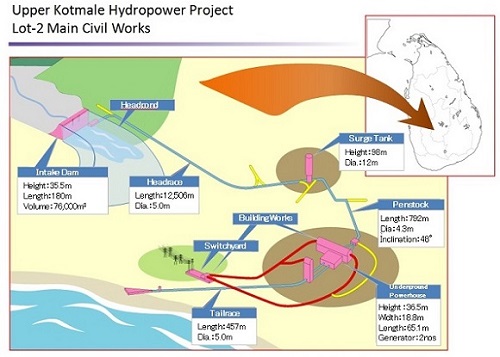 Figure 1 Diagram of Main Civil Works |
As shown in Fig-1, the Lot-2 Main Civil Works are divided into nine integral sections:
1. Intake Dam (Picture-1、Concrete Gravity Type、height 35.5m、length 185m);
2. Headpond (Picture-2);
3. Headrace Tunnel (Picture-3、length 12.5km、diameter 5.0~5.8m);
4. Surge Tank (Picture-4、height 98m、diameter 8.5m);
5. Penstock (Picture-5、length 790m、diameter 4.3~1.45m, inclination 48°);
6. Underground Powerhouse (Picture-6、length 60m、height 36.5m、width 19m);
7. Tailrace Tunnel (Picture-7、length 459m、diameter 5.0m);
8. Switchyard (Picture-7) and
9. Auxiliary building works(Picture-8、St. Clair Viewing Gallery, Control Buildings, Guardhouses, etc.).
Clearly, this is representative of so-called “mountain civil engineering” as the Contract involves a wide diversity of complex engineering activities. Moreover, the Site extends over a large area. As an example, the distance from the site of the Intake Dam to the site of the Switchyard is approximately 12km in a straight line and approximately 23km by way of national road B412 following its improvement under Lot-1: Preparatory Works, by Maeda Corporation.
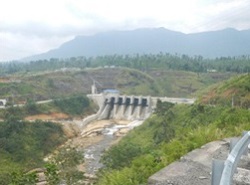 Picture-1 Intake Dam |
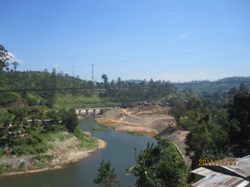 Picture-2 Headpond |
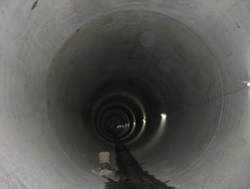 Picture-3 Headrace Tunnel |
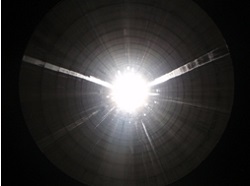 Picture-4 Surge Tank (from the bottom) |
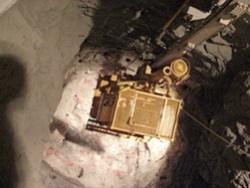 Picture-5 Penstock (Pilot Tunnel) |
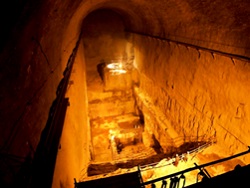 Picture-6 Underground Powerhouse |
As can be seen from these data, if the Lot-2 works are compared with other famous national projects around the world, the Lot-2 works are not large. However, the work for each section was extremely challenging and required the use of ingenious construction methods as opposed to those more traditionally employed on civil engineering projects. Whilst not an eye-catching contract employing full leading edge civil engineering technologies the construction of the UKHP reminded us of the pure joy of “monozukuri” (the making of things), through engaging in civil engineering works.
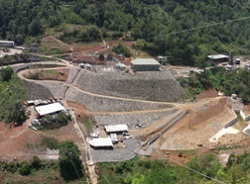 Picture-7 Switchyard |
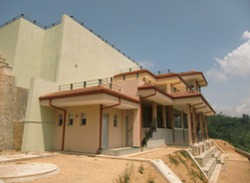 Picture-8 St.Clair Viewing Gallery |
◆Longest Tunnel and Largest Underground Space in Sri Lanka
Throughout the project difficulties were encountered in completing the works. These included the civil war (which didn’t end until 2008), the shortage of construction materials due to the demand from mega projects such as the Beijing and London Olympics and the shortage of skilled workers. Other local difficulties arose because the Intake Dam and Headpond construction sites were located adjacent to a residential zone.
At a total length of approximately 17km, the tunnels are the longest tunnels in Sri Lanka. Unsurprisingly there were no local skilled workers for tunneling works of this magnitude. As a result, workers from several countries were recruited including those from Indonesia, Malaysia and Nepal.
The most difficult parts however were (a) the Penstock Tunnel as it is inclined at a maximum of 48 degrees to the horizontal and (b) the vertical shaft of the Surge Tank as it is 98m in height. The Underground Powerhouse is a 33,000m3 rock cavern the plant located therein generating a maximum power output 150MW. It is clearly not possible to introduce each and every detail of the works in this piece. Nevertheless, a number of issues can be selected that adequately illustrate ingenuity of construction.
◆Mix design of Concrete for backfilling the Penstock
The external area of the Penstock was filled with concrete after the installation of the steel pipes. Clearly it is not easy to place concrete in inclined tunnels at 48 degrees to the horizontal even if special equipment was easily available, which it was not. We therefore employed a method which became known as the chute casting method. The chute material, chosen was a φ450mm PVC pipe cut in half (simply for ease of cleaning and checking abrasion). However, this method of placing concrete was not without its problems, the most obvious being velocity control and material segregation. Indeed, during trial casting, it was recognized that the physical effect of such placement meant that the concrete was no longer able to satisfy the relevant requirements. The only solution therefore was to change the characteristics of the concrete by changing its mix proportion. As a result, of raising the sand/aggregate ratio and increasing the cement paste rate, we successfully obtained more viscosity which reduced placement velocity and consequentially increased resistance to segregation.
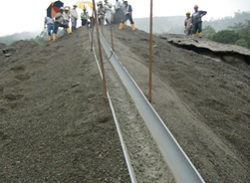 Picture-9 Trial Chute Casting |
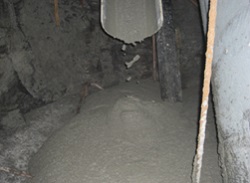 Picture-10 Condition of Concrete at Casting Place |
◆Sky Platform for Surge Tank Concrete Lining Work
As well as the Penstock, the external area of the Surge Tank steel lining had to be filled with concrete. Work here was undertaken at an elevation of up to 1,194m. Above the steel lining a concrete lining had to be constructed, such work being carried out up to an elevation 1,248m. Originally the plan was to use a slip form usually used in dam construction. However, in consideration of safety and the progress of the work, the sky platform was devised that entirely covered all cross sections of the Surge Tank. By employing the sky form, it was possible to make scaffolding and formwork mutually independent of one another and to obtain better workability. In addition it eased difficulties that would have otherwise been an issue due to the work being carried out at a very high elevation.
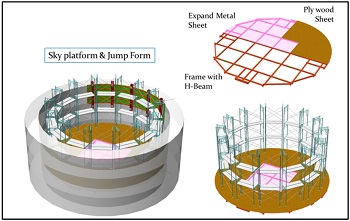 Figure-2 Image of Sky Platform |
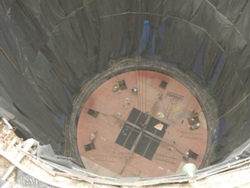 Picture-11 Setting Sky Platform |
◆Message to the Youth Engineers
I was 27 years old when I first visited Sri Lanka to work on the UKHP Lot-1. It was not until I was 36 years old that I returned to Japan. This means that now after 9 years of living in Sri Lanka, I have spent 25% of my entire life and 75% of my entire time with Maeda Corporation at Kotmale, Sri Lanka. Whilst this may seem to be a long period of time, I can honestly say that my experience on this project was worth every minute of my time Please therefore be proud of the ability of Japanese engineers’ as they are surely amongst the very best in the world. However, having said that, when we look around the world, we may find that there are technologies employed by others that sometimes surpass those of Japan. Go abroad if any good opportunity arises and in so doing you will realise that by releasing your spirit of engineering you will be able to reach your furthest goals. You may nevertheless face difficulties in coming to grips with different aspects of construction, safety control, contract administration, filing and even in just everyday life some things of which you cannot experience in Japan. In this globalized world, many companies are trying to be global players and strengthening their education system for their staff who want to work overseas. If the opportunity arises therefore I hope that you will be brave enough to take it and face the challenges ahead of you with a pride that comes with being Japanese.
【References】
1) International Development Journal September 2011, “Sri Lanka: Large Scale Hydropower with precious own resources”
2) Electric Power Civil Engineering, November 2014,”Development of Generation for Peak Demand in Sri Lanka”
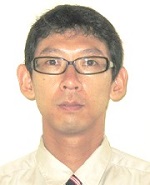 |
Satoshi KOBAYASHI Maeda Corporation International Operations Branch, Contract Management Division, Assistant Engineer Kobayashi-san joined Meada Corporation in 2002 since that time he has worked on overseas contracts including the Rehabilitation of National Road Route No.7 (Cambodia); the Improvement of the Circumferential Road in the Pohnpei Island (Micronesia); and then from August 2005 he was engaged on the Upper Kotmale Hydropower Project Lot-1: Preparatory Works. Upon the award of the contract for the construction of the the UKHP Lot-2 Main Civil Works to Maeda-Nishimatsu Joint Venture, he was permanently engaged to the UKHP. On July 2014, he returned to Japan after the completion of the project to undertake his present position. |
What's Happening
- 2015/10/11-14
ASCE Annual Conference 2015 (The New York Marriot Marquis, NY, USA)
- 2015/10/28-30
KSCE Annual Conference 2015(GSCO, Gunsan, Korea) - 2015/11/28
The International Symposium on “River Technology for Innovation and Social System” (Kyoto, Japan)
http://river-innovation.net/index_en.html
Updates
- The summary of feature articles in the JSCE Magazine is available on the JSCE website.
http://www.jsce-int.org/pub/magazine - Concrete Committee International Newsletter No. 42
http://www.jsce.or.jp/committee/concrete/e/newsletter/Newsletter.htm - Journal of JSCE
The Journal of JSCE is the collection of research papers which can be viewed on the JSCE website.
https://www.jstage.jst.go.jp/browse/journalofjsce - Disaster Fact Sheet
http://committees.jsce.or.jp/disaster/ - IAC Students and Alumni Network
http://www.jsce-int.org/IAC_network/registration
IAC News Subscription
The IAC News is one of the communication tools to share information and ideas with the members. We would like to invite you, your friends and colleagues to join the communication and to subscribe the IAC News. Please register online: (http://www.jsce-int.org/node/150). We look forward to meeting you.
◆Editor's postscript
In this special issue, we focus on Upper Kotmale Hydropower Project in Sri Lanka that was the theme of IAC Japanese Civil Engineers the Global Leaders Symposium Series Vol.5 held on July 22, 2015.
I have marveled at the scale of the overseas projects every time, which is huge for me working in the office. In the symposium, a TV program was screened that featured an engineer working for this project and his child who had traveled a long distance to see his father. I realized how much effort the engineers working overseas put in.
The symposium series vol.6 will be held by the end of fiscal 2015. I look forward to the theme of the next one. (H.T.)
